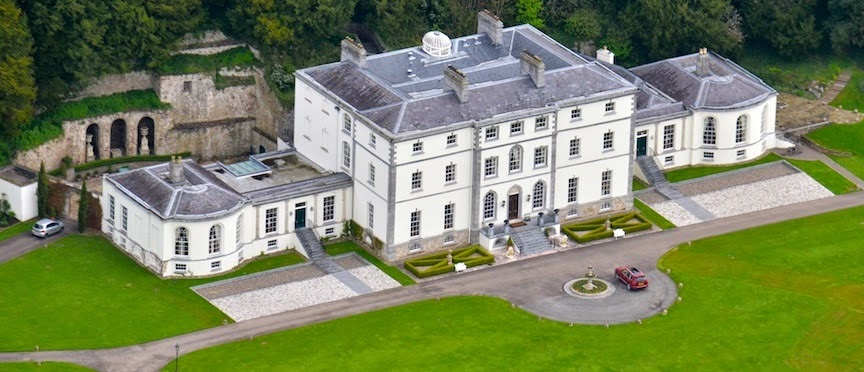THE GROVES OWNED 2,140 ACRES OF LAND IN COUNTY DONEGAL
THOMAS GROVE, of Castle Shanahan, County Donegal (son of Thomas Grove), living there 1666-77, Commissioner of Assessments for the county, 1655, Collector of Customs in Londonderry, 1643-74, High Sheriff of County Donegal, 1664, married Margaret, only daughter of Peter Benson, of Elagh, Alderman of Londonderry, and had issue,
WILLIAM, his heir;
Frances; Elizabeth; Helen; Margaret; Ann; Prudentia.
Mr Grove died in 1681, and was succeeded by his only son,
WILLIAM GROVE (1662-97), of Castle Shanahan, who served through the siege of Derry, 1688, and purchased the Manor of Kingston, 1684, from the Kingsmills.
Mr Grove married firstly, in 1684, Constance, daughter of Major John Kingsmill, of Andover, Hampshire.
She died in 1687, aged 22.
He wedded secondly, in 1688, Elizabeth, eldest daughter of Sir James Leigh, Knight, of Cullionmore, County Westmeath.
Mr Grove was murdered by rebels in 1697, having had issue,
Thomas, dsp 1724;
WILLIAM, of whom presently;
James, of Grovehall;
Constance.
The second son,
WILLIAM GROVE, of Castle Grove, which he built 1730, High Sheriff of County Donegal, 1727, espoused Susanna, daughter of Philip Barry, of Kilcarra, County Meath, and had issue,
Thomas, b 1719; dsp 1792;
James, b 1725;
William, 1734-93;
Richard, d 1766;
Humphrey;
CHARLES, of whom presently;
Judith; Elizabeth.
Mr Grove died in 1742/3.
His youngest son,
THE REV CHARLES GROVE (1742-1818), Vicar of Kilmacshalgan and Templeboy, County Sligo, married Mary Gilmour, and had issue,
William (Rev), dsp 1857;
Mary Susanna, m 1794 her cousin Thomas Grove (took name of BROOKE);
DOROTHY, of whom presently;
Helen Elizabeth.
The younger daughter,
DOROTHY GROVE, wedded, in 1802, John Wood, of 9th Light Dragoons, son of James Wood, of Woodville, County Sligo, and had issue (with a daughter), a son,
JAMES GROVE WOOD GROVE JP DL (1803-91), of Castle Grove, Barrister, High Sheriff of County Donegal, 1855, who adopted the name of
GROVE in 1863 on succeeding to the Castle Grove Estate.
He wedded, in 1843, Frances Judith, daughter of Robert Montgomery, of Convop House, County Donegal, by Maria Frances Stewart his wife, niece of Robert, 1st Marquess of Londonderry, and granddaughter of the 1st Marquess of Drogheda, and had issue,
JOHN MONTGOMERY CHARLES, his heir;
Robert Thomas Wood, Captain RN;
Charles William;
Mary Susanna Frances; Dorothea Alice; Frances Mary Ellen.
Mr Grove was succeeded by his eldest son,
JOHN MONTGOMERY CHARLES GROVE JP (1847-1920), of Castle Grove, who married, in 1886, Lucy Georgina, daughter of Major-General William Maunsell Gabbett, East India Company's Artillery, and had issue,
JAMES ROBERT WOOD;
Lucy Dorothea Montgomery, 1892-1908.
Mr Grove was succeeded by his son,
MAJOR JAMES ROBERT WOOD GROVE (1888-1969), who married, in 1920, Eileen Beatrice, daughter of George Edmonstone Kirk, and had issue, an only child, Bridget Grove, who was born and died in 1927.
When Major Grove died in 1969, Castle Grove was inherited by Commander Peter Colin Drummond Campbell-Grove (Cdr Peter Campbell LVO OBE DL RN), Equerry to HM The Queen, 1957-60, who married, in 1966,
the Lady Moyra Kathleen Hamilton, daughter of James, 4th Duke of Abercorn, and sister of the present Duke of Abercorn, KG.
CASTLE GROVE, near Letterkenny, County Donegal, is a two-storey, four-bay Georgian country house, built
ca 1750, though there may be elements of an earlier dwelling of
ca 1695.
It was altered about 1825 by the addition of two-storey wings.
Castle Grove retains much of its early character and form, despite alterations to accommodate new uses.
Its visual appeal and integrity are enhanced by the retention of salient fabric to the main block, including timber sliding sash windows, natural slate roof, and timber panelled door.
The fine pedimented Tuscan entrance porch with sidelights and entablature provides an attractive focus and gives this building a classical architectural character that is typical of its type and date.
The door-case dates from 1750 and was probably moved from another location to the site when the house was altered
ca 1825, and the present entrance front was added.
These 1825 alterations and modifications were carried out by Thomas Brooke (née Grove).
This building may contain fabric of an earlier house to site, apparently built
ca 1695 by the Grove family.
The Grove family originally settled in the area in 1656.
They originally had a dwelling at nearby Castle Shanahan to the north, which was apparently burnt to the ground in 1689 by Jacobite forces retreating from the siege of Londonderry, a fate suffered by numerous properties in this part of County Donegal.
The Groves decided to rebuild a short distance to the south of their original residence.
The original house was either greatly altered or rebuilt
ca 1750.
The present house originally had the Tuscan porch to the main entrance, though it was later moved following the construction of a new block to the front about 1825.
Occupying attractive mature landscape grounds to the north-east of Letterkenny, this building is one of the finest houses in the area, and is an important element of the built heritage of County Donegal.
The now-altered but appealing conservatory to the south-west of the entrance front, and the single- and two-storey wings to site add to the setting and context.
This building forms the centrepiece of a group of related structures along with the complex of outbuildings and former estate manger's residence; walled garden to the south-west; gardener's house; and gate lodge to the west.
Castle Grove is now a country house hotel and was purchased by the current owners, Mary and Raymond Sweeney, from Commander Campbell in 1989.
First published in March, 2016.





















